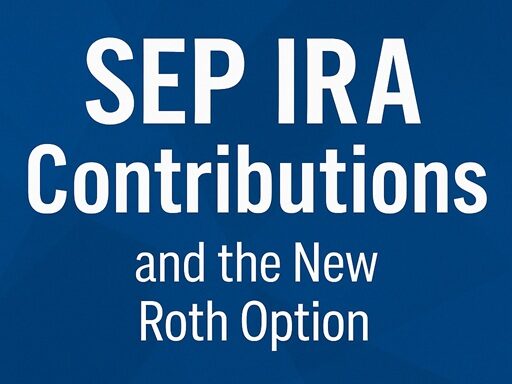SEP IRA Contributions and the New Roth Option Under SECURE Act 2.0
For small business owners, self-employed professionals, and solopreneurs, a SEP IRA (Simplified Employee Pension Individual Retirement Account) is a powerful and flexible way to save for retirement. With the passage of the SECURE Act 2.0, SEP plans now include the option for Roth contributions, giving investors new ways to diversify their retirement savings.
This article explains the SEP IRA contribution rules, eligibility guidelines, and the important updates introduced through SECURE Act 2.0.
Overview of SEP IRA Contributions
SEP IRAs are funded solely by employer contributions. One of the main advantages of a SEP IRA is that contributions are not mandatory every year. Employers have full discretion to decide whether to contribute in any given year.
No Mandatory Contributions
- Employers may choose to contribute in some years and skip others.
- There is no penalty for not contributing in a given year.
Uniform Contribution Requirement (If You Choose to Contribute)
- When you do decide to make contributions, you must contribute the same percentage of compensation for all eligible employees, including yourself.
- For example, if you contribute 15 percent of your own compensation, you must also contribute 15 percent of each eligible employee’s compensation.
Eligibility Requirements for Employees
The IRS requires employers to include employees in the SEP IRA plan if they meet the following conditions:
- They are 21 years of age or older.
- They have worked for the employer in at least 3 of the last 5 years.
- They have earned at least $750 in compensation during the year 2023. (The threshold was $650 for the years 2021 and 2022.)
Employers are permitted to use less restrictive eligibility criteria, but may not impose stricter requirements.
Contribution Limits for 2025
The contribution limit is the lesser of 25 percent of an employee’s compensation or $70,000. This limit is indexed annually for inflation.
Roth Contributions in SEP IRAs Under SECURE Act 2.0
Prior to 2023, SEP IRA contributions were limited to pre-tax dollars only. This meant that taxes on both contributions and earnings were deferred until distribution. However, the SECURE Act 2.0 introduced a significant change: Roth contributions are now permitted in SEP IRAs.
Roth Contributions Now Allowed
Employers may now offer employees the option to receive Roth contributions in their SEP IRAs. These contributions are made with after-tax dollars, and qualified withdrawals in retirement will be tax-free.
Employee Election Requirement
Employees must affirmatively elect to receive contributions as Roth. This election cannot be made by default. Additionally, while the IRS has yet to release formal model plan language, it has provided guidance (IRS Notice 2024-02) allowing employers to begin offering Roth contributions before those documents are finalized.
Benefits of Roth SEP Contributions
Incorporating Roth contributions into a SEP IRA structure provides meaningful advantages for retirement savers. These benefits include:
Tax-Free Growth and Withdrawals
Roth contributions are made after-tax, so qualified withdrawals in retirement are not subject to federal income tax. This is especially appealing to individuals who anticipate being in a higher tax bracket in retirement.
No Required Minimum Distributions (RMDs)
Beginning in 2024, Roth funds in employer-sponsored retirement plans, including SEP IRAs, are no longer subject to RMDs.
Tax Diversification
Combining pre-tax and after-tax retirement savings can provide greater flexibility and control over future tax liabilities.
Higher Contribution Limits
Roth SEP contributions offer much higher annual limits than Roth IRAs, making them an effective tool for high-income earners seeking to maximize tax-free retirement growth.
Important Considerations
Employers who offer Roth SEP contributions must still follow the same uniform contribution rules. If one employee elects Roth and another does not, the employer must still contribute the same percentage of compensation for each.
Since Roth contributions are taxable in the year they are made, employees must be prepared to pay income tax on those amounts.
All contributions, whether traditional or Roth, count toward the same annual SEP IRA contribution limit.
Conclusion
SEP IRAs have long been a valuable retirement planning tool for business owners and self-employed individuals. With the addition of Roth contribution capabilities under the SECURE Act 2.0, these plans offer even more flexibility and strategic tax advantages.
Whether you are looking to start a new SEP IRA, include the Roth option in your existing plan, or explore how this update can fit into your broader financial strategy, it is important to understand the rules and how to apply them.
Whether you want to invest in real estate, crypto, or private companies, we can help you get started with a self-directed IRA.



Let’s make your retirement investing work for you—not just Wall Street.






